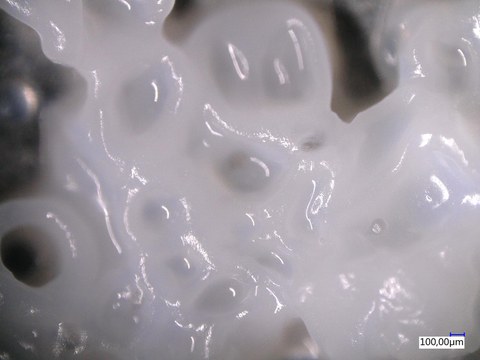Cleaning mechanisms of immerged systems

Raw milk fouling layer
The cleaning process of fouled organic material on heat transfer surfaces is a complex interaction of interfacial interactions, mass transfer, heat transfer, fluid forces and chemical reactions, which is not fully understood at present. The main objective in this research project is to achieve a fundamental knowledge of the cause-effect relationships in the cleaning of immersed systems. Whey protein in the form of WPI gel are to be used as a representative model fouling system. The research project is divided into three parts. The first part comprises the investigation of all material properties which are relevant for a cleaning process, specifically strength, viscoelastic characteristics, diffusion coefficient, surface topography, adhesion and cohesion force. These material parameters will be used in the second part of the project. Here a fundamental data base for a continuum-mechanical FEM model of the fouling layer will be set up. The fluid phase will be simulated with a fluid-structure interaction model (FSI) model, so that the cleaning process of WPI can be simulated. To validate and improve the FSI model, two established methods, namely fluid dynamic gauging (FDG) and local phosphorescence detection (LPD), are used in the third part. The FDG method enables to investigate the three stages of the cleaning process, swelling stage, uniform stage and decay stage. In combination with a particle size analyzer the particle size of removed particles can be determined. With the LPD method, it is possible to locally determine the cleaning time in different flow geometries under laminar and turbulent flow conditions. By correlation of the specific light intensity and the fouling layer thickness a removal rate as well as a change of the layer thickness can be quantified. The modeling approach will be developed further and based on this FSI model a tailored and system-specific cleaning strategy can be designed and validated. Furthermore well-established methodological approaches will be available, which can then be applied to any fouling layer.
Project funding:
Deutsche Forschungsgemeinschaft (DFG) - Projekt number 326771530
Project duration: 12.2017 – 12.2019
Project management and contact:
Project leader: Prof. Majschak
Project manager: Manuel Helbig
 © Nils Eisfeld
© Nils Eisfeld
Cleaning Technologies
NameDipl.-Ing. Manuel Helbig
Wissenschaftlicher Mitarbeiter
Send encrypted email via the SecureMail portal (for TUD external users only).
Cooperation partner:
Technische Universität Braunschweig, Fakultät für Maschinenbau, Institut für Festkörpermechanik

